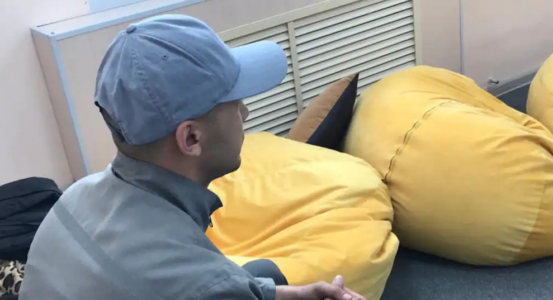
Former Islamic State terrorist from Kazakhstan warns others against jihadi recruiters
Daniyar was among some 150 Kazakhs featured in an infamous propaganda video that Islamic State (IS) released in 2013 bragging about the foreign recruits who joined the Islamic terrorist group in Syria.
Many of the men, women, and children in the video are thought to have since been killed in fighting or by the air raids in former IS-controlled territories in Syria and Iraq.
Daniyar – whose full name won’t be disclosed for privacy reasons – survived the war and returned to Kazakhstan to face charges of involvement in a terrorist organization and its propaganda.
Speaking at a prison in the Qaraghandy region in central Kazakhstan, where he is serving a 10-year sentence, Daniyar told RFE/RL he wants to share his story of grave “mistakes” and his disillusionment with IS so that he can prevent others from falling victim to jihadi recruiters.
The 29-year-old Daniyar admits lying to his wife when he took her to Syria in 2013. He also acknowledges getting one month of IS military training but claims he took part in IS military operations “only once.”
Growing up in a small, impoverished town in the province of Qaraghandy, Daniyar became interested in Islam, attended mosque, and learned Arabic. In 2013, Daniyar and his friends started watching jihadi videos online.
“The videos depicted Syrian Muslims as being oppressed and killed just for being Muslims, and that they needed help. It brought strong emotions and tears,” he says.
In hindsight, he knows it was recruitment material designed to lure people in the name of Islam to follow IS in Syria, Daniyar says.
But back then, Daniyar – who was 20 years old – fell for the IS propaganda and headed to Syria along with his new wife to fulfill what he thought was his religious duty.
In the autumn in 2013, IS released a video that shocked many people in Kazakhstan.
The 20 minutes of footage — titled The Muslim Family Of 150 People Who Moved To [Syria] — featured children and gun-brandishing adults who said they had come to Syria “for jihad at the Lord’s calling.”
The group spoke Kazakh, Russian, and Arabic inside a villa with a black-and-white Islamic State flag hanging on the wall. At the time, the terrorist group was still relatively unknown to the rest of the world.
More videos of Kazakh-speaking IS recruits were released in the following years, depicting young boys and girls getting weapons training.
Kazakh-speaking men – presented as fresh recruits from Kazakhstan – were shown receiving specialist sniper training and assault courses while also jogging in a desert.
Another IS video purportedly showed a Kazakh child executing two men – a Kazakh and a Russian – accused by IS of being foreign spies.
The majority of those who appeared in the videos didn’t wear face masks or balaclavas, subsequently making it easier for Kazakh authorities and relatives to identify them.
“My mother saw the video and recognized me,” says Daniyar, who appeared in the first clip.
Recalling the circumstances of how the footage was recorded, Daniyar told RFE/RL that initially he didn’t know the video would be distributed internationally.
“They filmed us and the children during a feast and shared it on the Internet, saying foreigners have brought their families here, they’re happy here,” Daniyar says. “I thought they were recording it just for themselves.”
He said when he found out that “the video was shown on news channels everywhere,” he called his mother in Kazakhstan to tell her he was in Syria.
“She cried and begged me to return or at least to send home my wife and our newborn son,” he says. But Daniyar wasn’t going to do that.
Daniyar got a second wife – a fellow Kazakh – in Syria. He fathered four children with his first wife and two with the second.
Daniyar was wounded in combat, which he claims was the only time he took part in fighting. Unable to fight because of his injuries, Daniyar says he was assigned to help IS widows, accompanying them to the bazaar and the hospital.
His claims cannot be independently confirmed.
In the final days of the self-declared caliphate in early 2019, Daniyar managed to escape Islamic State’s last stronghold, in Baghuz, “by hiding among women and children who were given safe passage” by Kurdish forces.
He eventually surrendered to the Kurds and Daniyar and his family were repatriated by the Kazakh government in a process that has brought back hundreds of its citizens from Syria and Iraq.
The Central Asian country has repatriated more than 700 Kazakh citizens in a special operation, called Zhusan, that began in 2018. Most of the returnees have resumed their “normal” lives after undergoing medical checkups, interrogations, and a stint in rehabilitation facilities.
But another 53 of the returnees have been imprisoned for terrorism-related offenses.
Daniyar has served three years of his 10-year sentence. He says he is happy to be alive and have his family in safety. He works as a barber in the prison and sends his salary to his family.
“I want to make amends for my guilt in front of my parents. I want to look after my children. I don’t want them to see war,” he says. “I know how terrifying war is.”
Daniyar wants to get a job at a mine or in trade once he is freed from prison so he can resume his normal life.
Source: RFERL





